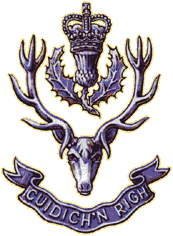Highlanders (Seaforth, Gordons and Camerons) facts for kids
Quick facts for kids The Highlanders, 4th Battalion, Royal Regiment of Scotland (4 SCOTS) |
|
|---|---|

Former cap badge of the Highlanders
|
|
| Active | 17 September 1994 – present |
| Country | |
| Branch | |
| Type | Infantry |
| Role | Mechanized Infantry |
| Size | Battalion 743 personnel |
| Part of | 20th Armoured Infantry Brigade |
| Garrison/HQ | RHQ – Cameron Barracks Battalion – Catterick Garrison |
| Motto(s) | Cuidich 'n Righ (Help the King) |
| March | Quick: Wee Highland Laddie |
| Insignia | |
| Tactical Recognition Flash | |
| Tartan | Gordon (kilt) Seaforth Mackenzie (trews) Cameron of Erracht (pipers and drummers kilts) |
| Hackle | Blue From Queens Own Cameron Highlanders/Queen's Own Highlanders (Seaforth and Camerons) |
The Highlanders, 4th Battalion, Royal Regiment of Scotland (often called 4 SCOTS) is a group of soldiers who are part of the British Army. They are a type of infantry unit, which means they are trained to fight on foot. They belong to a larger group called the Royal Regiment of Scotland.
Before March 28, 2006, The Highlanders was its own special army group. It was known as The Highlanders (Seaforth, Gordons and Camerons). This group was one of only two in the British Army that had a special motto in Scottish Gaelic. The motto, Cuidich 'n Righ, means "Help the King."
Contents
History of the Highlanders
The Highlanders regiment was first formed on September 17, 1994. This happened as part of a plan to change the army, called "Options for Change." It was created by joining two older regiments: the Queen's Own Highlanders (Seaforth and Camerons) and the Gordon Highlanders.
Early Deployments
After being formed, the new regiment spent two years in Northern Ireland, starting in April 1995. They were based at Ebrington Barracks in County Londonderry. Later, after being in different places in the United Kingdom, the battalion went to Bosnia in 2003.
Becoming 4 SCOTS
In 2004, the British Army decided to make some big changes. It was announced that The Highlanders would join with other Scottish infantry regiments. They would all become part of one large group called the Royal Regiment of Scotland. This joining happened on March 28, 2006.
The Highlanders were allowed to keep their old name as their main title. They also added a number to show they were a battalion within the new regiment. So, they became The Highlanders, 4th Battalion, The Royal Regiment of Scotland.
Recent Operations
Before joining the Royal Regiment of Scotland, the battalion moved to Germany. They were part of the 7 Armoured Brigade, which is known for its history as the "Desert Rats" from World War II. Here, they used special armoured vehicles called Warrior Infantry Vehicles.
From Germany, they went on six-month missions. They served in Iraq in 2005–06 and again in 2008. They also went to Afghanistan in April 2011.
In September 2015, the battalion moved from Germany to Catterick Garrison in the UK. There, they became a heavy protected mobility battalion. This means they use strong, protected vehicles and are part of the 20th Armoured Infantry Brigade. In 2020, the battalion joined a special group that tests new army ideas.
Uniforms and Traditions
The soldiers of 4 SCOTS now wear a specific type of tartan called the Government 1A pattern. Before 2006, when the regiment was separate, they wore the Gordon tartan when they wore kilts. They wore the Seaforth Mackenzie tartan when they wore special trousers called trews.
The pipers and drummers of the battalion wear kilts in the Cameron of Erracht tartan. The battalion gets its new soldiers from different parts of Scotland. These areas include the Hebrides, the Northern Isles, and counties like Inverness-shire and Aberdeen. The main office for the battalion is at Cameron Barracks in Inverness.
The battalion also has the British Army's only team for a sport called shinty. This team is known as The Scots Shinty Club. Because the 4th Battalion often serves abroad, their team usually only plays in cup matches.
Images for kids
-
Members of the battalion on Saddleworth Moor during the 2018 United Kingdom wildfires.


